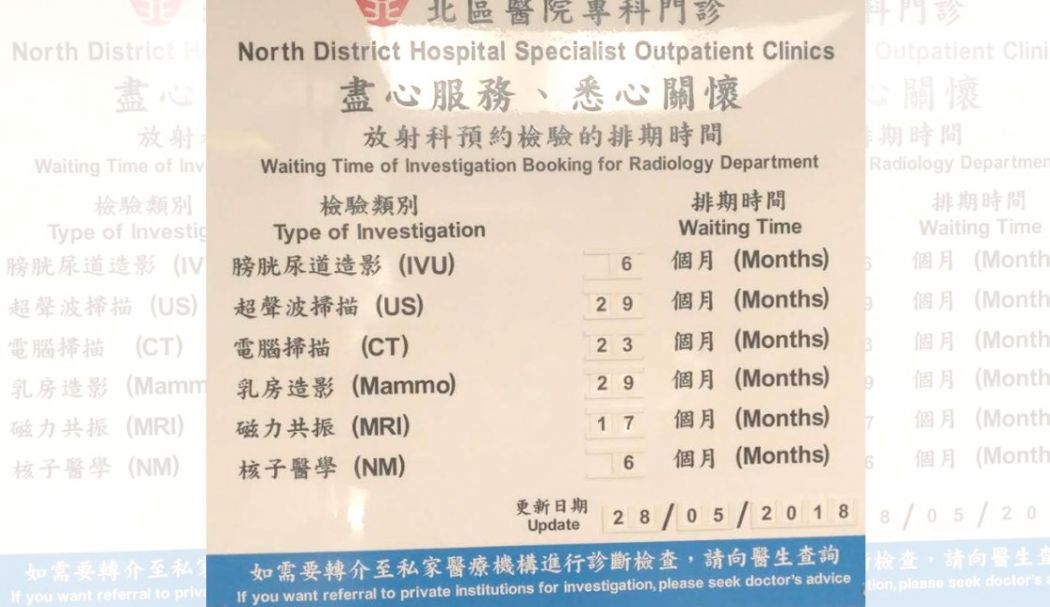I recently visited North District Hospital and saw a sign that struck me for its absurdity. A 29-month wait for an ultrasound, a 29-month wait for a mammogram, a 23-month wait for a CT scan and a 17-month wait for an MRI. On the more “reasonable” end was a 6-month wait for an intravenous urogram or a nuclear medicine exam. My understanding is that this is pretty typical for Hong Kong’s public hospitals.

Imagining if my family or I needed one of those tests, I found myself getting increasingly impassioned. A more than two-year wait would surely cause whatever condition that my loved one or I had to get worse and possibly progress beyond the point of treatment. While the best way to alleviate stress on the healthcare system is preventative treatment before serious and costly conditions arise, the long wait for tests such as a mammogram to screen for breast cancer or an ultrasound to confirm certain diagnoses so that treatment can start early on demonstrates that Hong Kong’s healthcare system is, at best, inefficient or, at worse, corrupt.
I do not claim to be an expert on Hong Kong’s healthcare system nor do I want to blame the Hospital Authority’s (HA) management of the city’s public hospitals. Perhaps it just doesn’t have enough funds to buy more medical imaging equipment or hire more staff to run the tests.
In 2017, the HA’s expenditure increased by HK$3.2 billion, reaching HK$62 billion and causing a deficit of HK$1.52 billion. While the government’s budget increased funding for the HA by HK$6 billion in 2018-2019 to HK$61.5 billion, it is obvious it will not be enough to cover the rising costs of running the city’s public hospitals, much less provide funding for much needed medical equipment and the staff to operate them.

Meanwhile, the government plans to distribute HK$4,000 to some 2.8 million Hongkongers in a one-off handout costing the government approximately HK$11.2 billion. Although lauded by some lawmakers and designed to satisfy the public pressure calling for more to be done for the city’s needy, the one-off handout will not help those 2.8 million residents in the long-run. Only investment in social welfare services will help improve people’s standard of living.
When confronted with the question of whether a patient can wait two years for the recommended imaging or test, staff at the public hospital just said they could write a referral to a private clinic, where the queues for these tests are much shorter. The sign I saw at North District Hospital also explicitly states that doctors could give referrals to private hospitals if the patient wants. Directly or indirectly, this essentially encourages patients to seek these tests in the private sector, paying exorbitant prices that regular wage-earners in Hong Kong can’t possibly afford, or potentially face worse consequences after a two-year wait. For a low-income household in Hong Kong, or even a median wage-earner making HK$15,819 per month, an MRI scan at a private hospital can run from between HK$3,000 to HK$20,000, potentially wiping out more than an entire month’s income. This only enriches the private sector for each person who decides that health is more important than their savings or their next month’s rent. And what a horrible choice to be making.

Imagine introducing one or two new machines at each of the city’s public hospitals with part of the government’s HK$138 billion surplus from 2017-2018 that the government just doesn’t seem to know how to spend. Imagine cutting down wait time by even a few months. I chance this is more worthwhile than a single handout that does nothing to relieve low-income people’s stress and suffering.
It is never too late for the Hong Kong government to affirm its commitment to low-income households and ameliorating income inequality through better budgeting and allocating needed funds towards social welfare and social healthcare issues.
